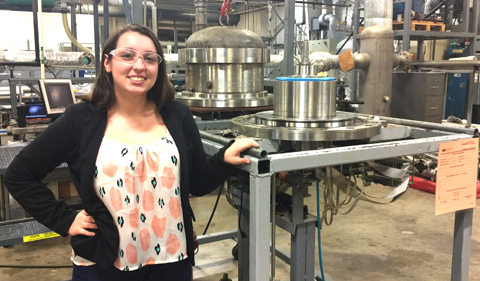
Ohio University Physics major Taylor Gardner at OHIO’s Institute for Corrosion and Multiphase Technology
By Taylor Gardner (B.S. Physics, Honors Tutorial College, Class of 2018)
I had the opportunity to be a summer intern at Ohio University’s Institute for Corrosion and Multiphase Technology. I worked under the direction of Dr. Srdjan Nesic, Russ Professor of Chemical Engineering and ICMT’s director.
My project, “Dynamic Water Wetting Study in a Small Scale Apparatus,” involved studying how changing the wettability of a pipe surface can impact the flow patterns and phase wetting regime of oil-water flow. The “pipe” used in the study is a “doughnut cell”—a flow chamber shaped as a small annular loop that rotates a liquid solution between a bottom metal plate and a top plastic plate using a central motor. Wettability is the ability a droplet has to adhere to or repel from that surface and the phase wetting regime refers to the surface being wetted with oil or with water.
While the total volume of the oil-water solution remained the same, the ratio of oil to water changed between each trial. Since water-wet surfaces can expedite corrosion production, I wanted to know the relationship between the surface wettability and flow patterns of those solutions and when they would yield a water-wet over oil-wet bottom surface. Three materials were used (PVC, stainless steel, and carbon steel) that range in wettability (hydrophobic or “water-repellant” to hydrophilic or “water-adherent”).
The tests mimic what occurs in the pipelines used in the oil and gas industry. Manipulating the ratio of salt water to oil may hinder the growth of corrosion, which remains one of the major causes for pipeline failure.
My analysis at this point shows that surfaces that exhibit hydrophilic tendencies tend to show water wet surfaces at much lower water cuts and higher flow velocities compared with hydrophobic surfaces. While this seems logical, this study was one of the first to solely focus on that relationship. This is a first step in a more involved study. Next steps could involve changing the type of oil used between trials, changing pressure between trials, or monitoring more physicochemical characteristics of the solutions such as pH levels.
Working at the ICMT was a wonderful and eye-opening experience. Dr. Nesic and ICMT Project Leader Dr. Luciano Paolinelli guided me in developing a solid research project. At the same time, I was given a good deal of independence and responsibility. I loved developing my research skills and the experience provided an opportunity to see what a job in industry might entail. My time at the ICMT helped me to develop goals I hadn’t imagined prior to this summer. Upon graduation, I want to continue studying fluid dynamics in graduate school or work in a lab that focuses on solutions to infrastructure challenges faced by the various energy industries.



















Comments